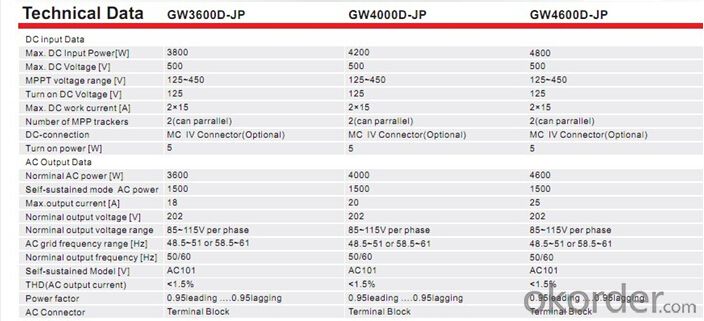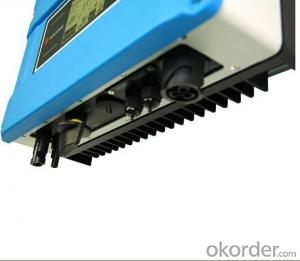On grid solar inverter GW3000D-JP
OKorder Service Pledge
OKorder Financial Service
You Might Also Like
GW3000D-JP
JP Series Inverter is suitable to the domestic applications, and designed under modern ID concept, it has created a new standard for inverter technology with more advanced reactive compensation technology and dual MPPT trackers. Not only be able to connect with two phase grid system, this model but also could run as off-grid model, and the wide range of frequency of 50/60Hz makes it a good choice for Japan market. Moreover, the specialized monitor could perfectly control the inverter operation and data logging. IP65 high protective class of housing ensures the inverter work persistently and steadily under all critical environment.
Datasheet

- Q:What is the importance of insulation resistance measurement in a solar inverter?
- Insulation resistance measurement in a solar inverter is crucial as it helps ensure the safety and efficiency of the electrical system. By measuring the insulation resistance, any potential faults or deteriorations in the insulation can be detected, preventing electrical leakage or short circuits. This measurement also helps identify any insulation breakdowns that may compromise the performance and reliability of the solar inverter. Ultimately, insulation resistance measurement is essential for maintaining the integrity of the solar inverter and ensuring the safety of both the electrical system and the people using it.
- Q:What is the role of a grid connection feature in a solar inverter?
- The role of a grid connection feature in a solar inverter is to facilitate the transfer of electricity between the solar panels and the electrical grid. It allows for the seamless integration of solar power into the existing electrical infrastructure, enabling excess electricity generated by the solar panels to be fed back into the grid, and drawing power from the grid when the solar panels are not producing enough electricity. This grid connection feature also ensures that the solar system meets the safety and regulatory requirements of the local electrical grid.
- Q:What is the difference between a PV inverter and a solar inverter?
- The main function of photovoltaic grid-connected inverter is to convert the DC power of the solar PV module into the same frequency as the sinusoidal AC power of the grid (the grid is generally AC power grid, DC can not be directly connected)
- Q:How does a solar inverter handle voltage sags or swells in the grid?
- A solar inverter handles voltage sags or swells in the grid by continuously monitoring the grid voltage. When a sag or swell is detected, the inverter adjusts its output voltage accordingly to maintain a stable and consistent supply of power. It does this by regulating the amount of power it injects into the grid or by temporarily disconnecting from the grid to protect itself and other connected devices. This helps to prevent damage to the inverter and ensures that the solar system can continue operating efficiently even during voltage fluctuations.
- Q:What are the key features to consider when choosing a solar inverter?
- When choosing a solar inverter, there are several key features to consider. Firstly, the power rating or capacity of the inverter should match the size of your solar panel system to ensure efficient energy conversion. Additionally, the efficiency rating of the inverter is important as it determines how much energy is lost during the conversion process. It is also crucial to look for an inverter with reliable and durable components to ensure long-term performance and minimize maintenance costs. Other important features include the presence of monitoring capabilities, such as data logging and remote monitoring, which allow you to track the performance of your solar system. Finally, considering the warranty and customer support offered by the manufacturer is essential to ensure adequate support and protection for your investment.
- Q:What are the installation requirements for a solar inverter?
- The installation requirements for a solar inverter typically include a suitable mounting location, adequate ventilation, and a compatible electrical system. It should be installed in an area with good sunlight exposure and away from any shading or obstructions. The inverter should be mounted securely on a sturdy surface, preferably indoors or in a weatherproof enclosure. Proper grounding and electrical connections are also necessary to ensure safe and efficient operation. It is essential to follow the manufacturer's guidelines and local electrical codes during installation.
- Q:Can a solar inverter be used in regions with high levels of dust or debris?
- Yes, a solar inverter can be used in regions with high levels of dust or debris. However, it is important to regularly clean and maintain the inverter to ensure optimal performance and prevent any damage caused by the accumulation of dust or debris.
- Q:What is the role of a power control unit in a solar inverter?
- The role of a power control unit in a solar inverter is to regulate and control the flow of electricity between the solar panels and the grid. It ensures maximum power output from the solar panels by optimizing their performance and matching it with the electrical requirements of the grid. Additionally, it provides protection against overvoltage, overcurrent, and other electrical faults to ensure safe and efficient operation of the solar inverter system.
- Q:What is the role of a solar inverter in preventing system failures?
- The role of a solar inverter in preventing system failures is to convert the direct current (DC) electricity generated by solar panels into alternating current (AC) electricity that can be used to power homes and businesses. In addition to this conversion, solar inverters also play a crucial role in ensuring the stability and efficiency of the entire solar power system. They monitor and regulate the voltage and frequency of the electricity being generated, protecting the system from overvoltage, undervoltage, and other electrical abnormalities that can potentially lead to system failures. By constantly monitoring and adjusting the electrical output, solar inverters help maintain the health and reliability of the solar power system, ultimately preventing potential failures and maximizing the overall performance.
- Q:Can a solar inverter be used with different battery chemistries?
- Yes, a solar inverter can be used with different battery chemistries as long as the inverter is compatible with the specific battery chemistry and its voltage requirements. However, it is important to ensure that the inverter is designed to work efficiently with the particular battery chemistry to avoid any compatibility issues or potential damage to the system.
1. Manufacturer Overview |
|
|---|---|
| Location | |
| Year Established | |
| Annual Output Value | |
| Main Markets | |
| Company Certifications | |
2. Manufacturer Certificates |
|
|---|---|
| a) Certification Name | |
| Range | |
| Reference | |
| Validity Period | |
3. Manufacturer Capability |
|
|---|---|
| a)Trade Capacity | |
| Nearest Port | |
| Export Percentage | |
| No.of Employees in Trade Department | |
| Language Spoken: | |
| b)Factory Information | |
| Factory Size: | |
| No. of Production Lines | |
| Contract Manufacturing | |
| Product Price Range | |
Send your message to us
On grid solar inverter GW3000D-JP
OKorder Service Pledge
OKorder Financial Service
Similar products
New products
Hot products
Hot Searches
Related keywords






























